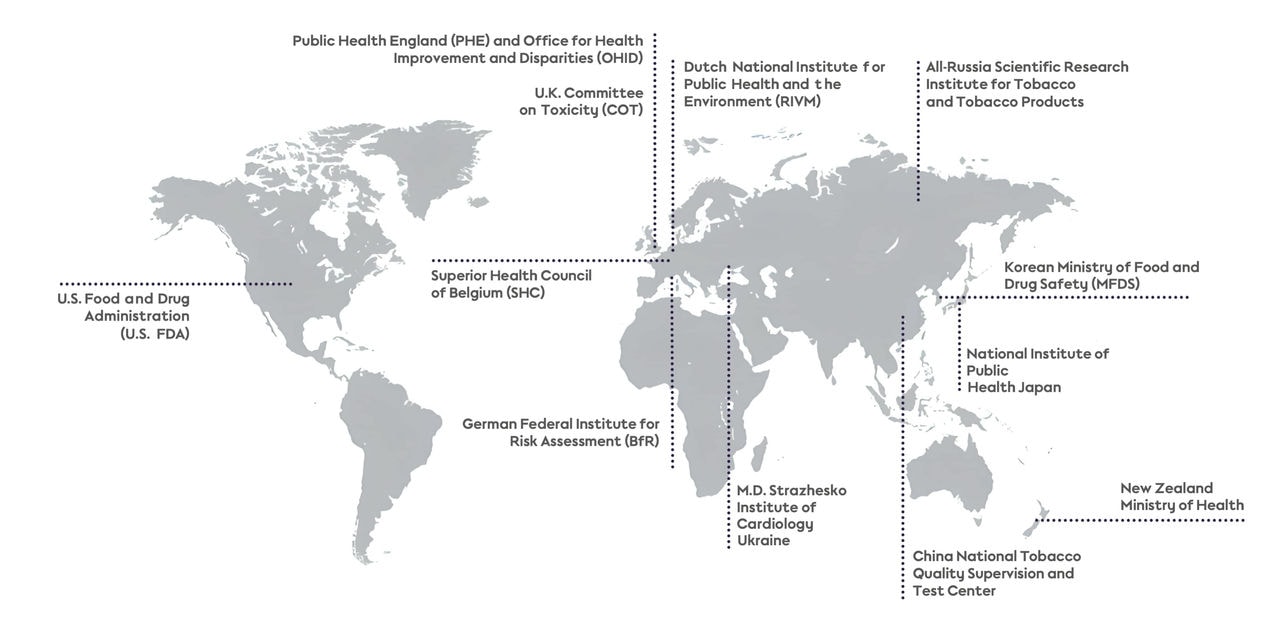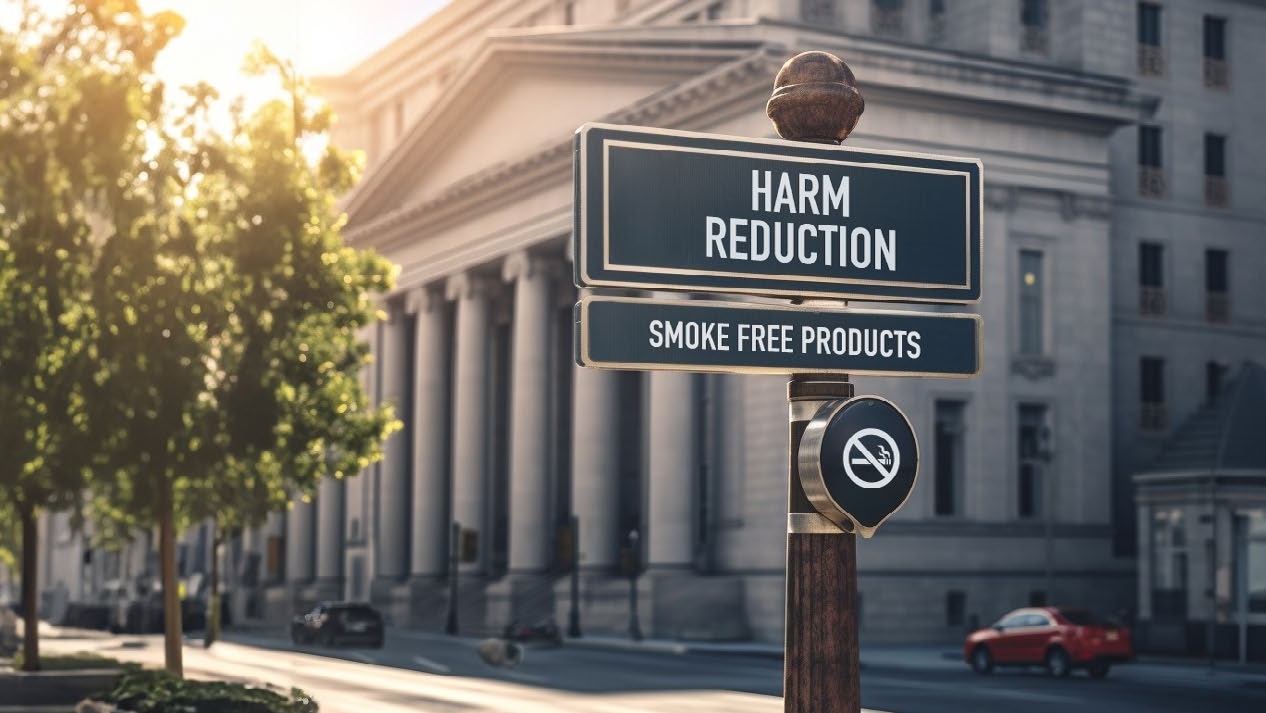Government health authorities’ view on heated tobacco products
U.S. Food and Drug Administration (FDA)
Within the FDA, the Center for Tobacco Products is responsible for regulating the manufacturing, marketing, and distribution of tobacco products.
In 2017, the Agency announced a comprehensive plan for tobacco and nicotine products, with the goal of “striking an appropriate balance between regulation and encouraging the development of innovative tobacco products that may be less dangerous than cigarettes.”
In 2019, following an assessment of the premarket tobacco product applications (PMTA) for the tobacco heating system, THS 2.2, commercially known as IQOS 2.4. (and three HeatSticks variants), the FDA authorized the marketing and sale of the product in the U.S. as being “appropriate for the protection of public health.”
In July 2020, the Agency granted modified risk orders with reduced exposure information for THS 2.2, which was the first electronic nicotine-containing product to receive such orders.
According to the FDA’s press release: “In particular, the agency determined the company demonstrated that because the IQOS Tobacco Heating System heats tobacco and does not burn it, it significantly reduces the production of harmful and potentially harmful chemicals compared to cigarette smoke. Furthermore, studies showed switching completely from combusted cigarettes to the IQOS Tobacco Heating System significantly reduces the body’s exposure to 15 specific harmful and potentially harmful chemicals.”
Public Health England (PHE) and Office for Health Improvement and Disparities (OHID)
PHE was a governmental agency aimed at protecting and improving health while reducing health inequalities. PHE was disbanded in 2021 and its functions transferred to various agencies, with the tobacco-related functions moved to OHID.
Since 2014, PHE regularly reviewed the scientific evidence on smoke-free products and published eight reports, focusing on e-cigarettes, which is the most prominently used smoke-free product in the U.K. In 2018, the review included for the first time HTPs. It concluded that: ”Compared with cigarette smoke, heated tobacco products are likely to expose users and bystanders to lower levels of particulate matter and harmful and potentially harmful compounds. The extent of the reduction found varies between studies.”
They also placed HTPs lower on the continuum of risk, stating that “The available evidence suggests that heated tobacco products may be considerably less harmful than tobacco cigarettes and more harmful than e-cigarettes.”
U.K. Committee on Toxicity (COT)
U.K. COT is an independent scientific committee that provides advice to the Food Standard Agency, the Department of Health, and other government departments and agencies on matters concerning toxicity of chemicals. The agency reviewed the available evidence on two HTPs.
The assessment noted that “As the exposure to compounds of concern in the aerosol is reduced compared to conventional cigarette smoke, it is likely that there is a reduction in risk, though not to zero, to health for smokers who switch completely to heat-not-burn tobacco products.”
New Zealand Ministry of Health
In 2011, the New Zealand (NZ) government set itself a target of becoming smoke-free (achieving less than 5% daily smoking prevalence) by 2025. Since then, the government has increasingly focused on strategies to restrict smoked tobacco products through tax and regulatory measures such as plain packaging. However, by 2018, smoking prevalence was not falling as fast as the government hoped, having missed prevalence targets by a significant margin.
In 2020, the Smokefree Environments and Regulated Products (Vaping) Amendment Act 2020 was enacted to regulate smoke-free products, recognizing that these could help reduce smoking faster, mitigate health inequalities (the smoking rate was much higher within NZ’s indigenous Maori community), and get ‘back on track’ for the 2025 smoke-free goal. One of its stated purposes, enshrined in the Law itself, is to “support smokers to switch to significantly less harmful products”.
An official commentary from the NZ Parliament’s Health Select Committee explained: “The bill acknowledges that vaping products and heated tobacco products have lower health risks than smoking, and aims to support smokers to switch to these less harmful products.”
“The bill also recognizes that many smokers need support and advice to successfully move to less harmful alternatives, so the Bill allows for the provision of information and advice for those wishing to switch from smoking to vaping.”
German Federal Institute for Risk Assessment (BfR)
BfR is a branch of the Federal Ministry for Food and Agriculture and is responsible for the assessment of issues related to consumer protection.
In 2018, BfR analyzed the aerosol of IQOS tobacco heating system and reported the following, “Our study confirms that levels of major carcinogens are markedly reduced in the emissions of the analyzed “heat not burn" product in relation to the conventional tobacco cigarettes and that monitoring these emissions using standardized machine smoking procedures generates reliable and reproducible data which provide a useful basis to assess exposure and human health risks.”
In 2019, the BfR published an article titled “Heated Tobacco Products: A Review of Current Knowledge and Initial Assessments” confirming the findings of their previous study. “The German Federal Institute for Risk Assessment confirmed in its previous study substantially reduced toxicant levels for selected HTPs and provided an initial assessment in 2017. The profound reduction (>99%) of key carcinogens according to Fowles and Dybing, such as benzene and 1,3-butandiene, as well as substantial overall reductions of toxicants is expected to affect health risks, if people abstain completely from other tobacco products. Nicotine levels are still in range of conventional cigarettes, limiting the risk to switch back to conventional smoking tobacco.”

Dutch National Institute for Public Health and the Environment (RIVM)
RIVM is an agency of the Dutch Ministry of Health, Welfare, and Sport. In 2018, it published a preliminary assessment of IQOS in a factsheet that summarized its research on HTPs. RIVM concluded that "The use of heatsticks with the iQOS is harmful to health, but probably less harmful than smoking tobacco cigarettes."
In a 2020 publication, RIVM described the development of a methodology to estimate risk for HTPs relative to cigarettes. The authors concluded that “The CCE [change in cumulative exposure] was estimated to be 10- to 25-fold lower when using HTPs instead of cigarettes. Such a change indicates a substantially smaller reduction in expected life span, based on available dose-response information in smokers. However, this is a preliminary conclusion, as only eight carcinogens were considered so far.”
Belgian Superior Health Council (SHC)
SHC draws up scientific advisory reports that aim at providing guidance to political decision-makers and health professionals in Belgium. In April 2020, the Council provided a scientific advisory report on the toxicity and safety of HTPs. The Belgian health authorities—although adopting a precautionary approach and highlighting the need for additional long-term research—acknowledged that: “In clinical studies, following a switch from conventional cigarettes to heated tobacco products (IQOS or GLO), significant decreases in biomarker levels of exposure to harmful and potentially harmful constituents have been observed, although they are not considered to be completely safe. Favorable changes have also been noted in several biomarkers with biological impact, suggesting that there is potential for a decreased risk of disease if smokers switch from conventional cigarettes to heated tobacco products.”
China National Tobacco Quality Supervision and Test Centre (CNTQSTC)
CNTQSTC is a governmental laboratory responsible for tobacco products quality testing, and, as a member of the WHO Tobacco Laboratory Network (TobLabNet), is also a leading organization for tobacco regulatory science in China. In 2018, the center published a study comparing the level of harmful chemicals present in the THS 2.2 aerosol and the 3R4F reference cigarette smoke.
The authors stated that “the majority of mainstream constituents of THS 2.2 were reduced compared to 3R4F .” Specifically, they found that compared with the 3R4F reference cigarette, THS 2.2 produced “more than 90% fewer HPHCs [harmful and potentially harmful constituents], except for carbonyls, ammonia, and NAB [N-nitrosoanabasine], which were about 50–80% lower.” The authors cautioned “that reduction of harmful constituent emissions cannot be interpreted as equivalent to a proportionate harm/risk reduction for smokers.”
Japanese Department of Environmental Health
This department is a branch of the Japanese National Institute of Public Health (NIPH), member of the WHO TobLabNet. The NIPH is a government research and training organization charged with improving public health in Japan. In 2017, the department analyzed nicotine, tar, carbon monoxide, and tobacco-specific nitrosamines (TSNAs) in the mainstream aerosol, and nicotine and TSNAs in tobacco fillers of IQOS regular and menthol consumables, and compared their concentrations with those from reference cigarettes (3R4F and 1R5F) using WHO TobLabNet methods.
The authors concluded that “In this study, we could provide important information showing that the concentration levels of hazardous compounds in the mainstream smoke of iQOS are much lower than those in conventional combustion cigarettes. Although it is low concentration, toxic compounds are definitely included in the mainstream smoke of iQOS."
Ukrainian M.D. Strazhesko Institute of Cardiology
One of Ukraine’s leading national scientific centers, the M.D. Strazhesko Institute of Cardiology provides scientific advice for the Ukrainian government. In 2017, the institute conducted a 6-month clinical study which was published in a prominent national medical periodical Ukrainian Health. The study was focused on IQOS and the risk of cardiovascular diseases based on endothelial function and its determining factors. The authors highlighted that “The obtained results show significantly less harmful influence of ENDS/IQOS on cardiovascular function if compared to tobacco smoke” and that it confirms “ ... the possibility to consider them as harm reduction products for smokers who do not want or are not ready to quit smoking completely.”
All-Russia Scientific Research Institute for Tobacco and Tobacco Products
This government-sponsored institute aims to improve the manufacturing and quality of tobacco products, while reducing their toxicity. In a 2016-2017 study comparing cigarettes and HTPs, the authors stated that “As per conducted research it can be stated that tobacco heating system is a tobacco product with lower levels of toxic substances (excluding nicotine) compared to combustible cigarettes”.
Korean Ministry of Food and Drug Safety (MFDS)
Formerly known as the Korea Food & Drug Administration, MFDS is a government agency responsible for promoting the public health by ensuring the safety and efficiency of foods, pharmaceuticals, medical devices, and cosmetics as well as supporting the development of the food and pharmaceutical industries in South Korea.
The MFDS issued a statement on products that heat rather than burn tobacco, based on measurements performed in its own laboratories of three heat-not-burn (HNB) products including IQOS. It measured the nine HPHCs defined by the WHO as a priority list for mandatory reduction, as well as nicotine and “tar”.
MFDS results confirmed significant reductions of HPHCs in HNB products compared to cigarettes—but they omitted to discuss them. In its discussion, MFDS mentions that HNB products also contain carcinogens, like benzopyrene and benzene. What it fails to mention is that the levels measured are more than 10 times lower compared to the levels present in cigarette smoke. In fact, their own data show that these two carcinogens are reduced by more than 95% (for benzopyrene) and more than 99% (for benzene) when comparing the levels of HNB products to the top five most sold cigarette brands in Korea. When considering the nine measured HPHCs, the average reduction in HNB products compared with Korean cigarettes (top five most sold brands) is more than 90%.
On nicotine, MFDS commented that nicotine content in HNB products is similar to cigarettes. While the conclusion is correct, it is to be noted that similarity in nicotine content is intended as HNB products are meant to be a better alternative for adult smokers who would otherwise continue to smoke. In this context, product acceptance by adult smokers is essential. And to help product acceptance, the levels of nicotine should mimic cigarettes as closely as possible.
The MFDS also uses “tar” to compare products, an approach that is misleading because it gives no indication on the content of the HPHCs of the products. “Tar” is the total weight of solid and liquid residue in cigarette smoke after the weight of nicotine and water has been subtracted. However, it fails to give any indication about the composition of the smoke or aerosol, and in particular the amount of HPHCs. Many governments and public health organizations have supported removing “tar” measurements as being misleading to consumers. Beyond this, the aerosol of a smoke-free product is significantly different compared with the smoke of a cigarette. Thus, any comparison of cigarette “tar” and the weight of aerosol/vapor produced by products that do not combust is misleading, as the comparison is done between the weights of two mixtures with very different compositions and toxicities.
PMI’s public comment on the MFDS statement is available here.


